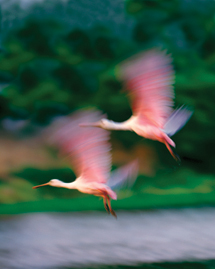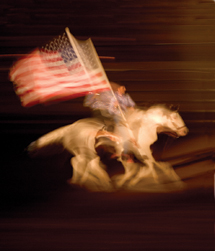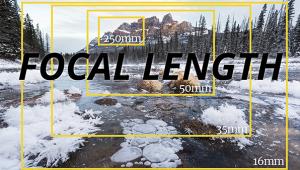Time Travel; Using Still Images To Imply Motion Page 2
Birds: 1/8 sec, pan |
|
 |
|
|
Dragging The Shutter
A dramatic variation of blurring motion is to use your flash and at the same
time use a long shutter speed. This creates a unique double exposure where the
blurred color and light from a long exposure time mixes with the sharply defined
elements that were recorded from the flash. It doesn't matter if the subject
is moving or if you move the camera. In both cases, the results can be amazing.
On my Italy trip, I photographed Carnival in Venice, and at night I used this
technique to combine blurred lights from shop windows with the costumed participants.
In the past, photographers had to calculate the exposure of the ambient light
plus the flash exposure, but now our digital cameras and sophisticated portable
strobes do all the work. I was using a Canon Speedlite 580EX and a Canon EOS-1Ds
Mark II, so I set the flash at E-TTL (the equivalent Nikon setting is i-TTL)
and started with the lens aperture at f/8. I used an ISO of 200 and set the
camera on Aperture Priority. By changing the aperture, the shutter speed was
forced to change as well, and that's how I controlled the amount of blur
I got. Since the 580EX is a dedicated flash, the camera knew what my aperture
was all the time. In this way, I got correct exposures that were balanced for
both the foreground subject and the background. I had complete control over
the amount of abstraction simply by controlling the shutter speed indirectly
by varying the aperture. It takes a few tries to get something good, but it's
well worth the effort in experimentation.
Rider: 1/40 sec, pan |
|
 |
|
|
Shutter Speed Guidelines
Waterfall with a wide angle lens--1/2 to 4 full seconds
Waterfall with telephoto lens--1/8 to 1 full second
Bicycles moving perpendicular to the lens axis, wide angle panning--1/4
to 1/15 sec
Bicycles moving perpendicular to the lens axis, telephoto panning--1/8
to 1/30 sec
Dancers, wide angle--1/4 to 1 full second
Dancers, telephoto--1/8 to 1/2 sec
Sports action (running), wide angle panning--1/4 to 1 full second
Sports action (running), telephoto panning--1/8 to 1/2 sec
Flowers blowing in the wind, wide angle--1/2 to 2 full seconds
Flowers blowing in the wind, telephoto--1/4 to 1 full second
Ocean waves, wide angle--1/2 to 20 full seconds
Ocean waves, telephoto--1/8 to 2 full seconds
Birds in flight, telephoto panning--1/15 to 1 full second
Jim Zuckerman is one of the world's best-known nature, wildlife, and travel photographers. His work has been sold in dozens of countries around the world in commercial, editorial, and fine art venues. Zuckerman is also a respected photo educator, and he is the author of 12 books on a wide range of photographic subjects. He leads international photo tours to exotic destinations such as Burma, Morocco, Turkey, Papua New Guinea, Peru, Indonesia, and Africa. You can sign up for his mailing list at: www.jimzuckerman.com. He also teaches online photography courses at BetterPhoto.com.
- Log in or register to post comments

















































